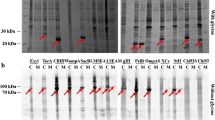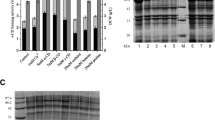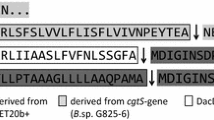Abstract
In the present study, we expressed the chiA74 gene of Bacillus thuringiensis in Escherichia coli K12 and demonstrated that the active ChiA74 enzyme was produced at a high level in this strain. The ChiA74 enzymatic activity (in units per milliliter) was approximately 500 % greater in E. coli K12 when compared to that produced in E. coli DH5α. Moreover, we showed that, when using our protocol, ChiA74 preparations obtained from recombinant E. coli K12 did not contain live bacteria, although transformable DNA (erm, bla genes) was detected. Nucleic acids were subsequently easily eliminated when samples were treated with magnesium. Importantly, ChiA74 was secreted by E. coli K12 and the active enzyme was shown to generate chitin-derived oligosaccharides (C-OGS) with degrees of polymerization of 2, 3, 4, 5, and 6. From an applied perspective, the C-OGS showed activity against various pathogenic bacteria. In addition, we demonstrated that ChiA74 was not toxic to Hek 293 and 3T3 L1 cells, i.e., the enzyme did not induce apoptosis or affect normal cellular cycle and also did not produce abnormal changes in cell morphology. The potential biotechnological use of producing endochitinase of B. thuringiensis in a microorganism recognized as safe (i.e., E. coli K12) is discussed.






Similar content being viewed by others
References
Aam BB, Heggest EB, Norberg AL, Sorlie M, Varum KM, Eijsink VGH (2010) Production of chitooligosaccarides and their potential application in medicine. Mar Drugs 8:1482–1517
Barboza-Corona JE, de la Fuente-Salcido NM, León-Galván MF (2012) Future challenges and prospects of Bacillus thuringiensis. In: Sansinenea E (ed) Bacillus thuringiensis biotechnology. Springer, New York, pp 367–384
Barboza-Corona JE, Gutierrez-Acosta OB, Imperial-Cervantes M, Bideshi DK, De la Fuente-Salcido N, Bautista-Justo M, Salcedo-Hernández R (2008) Generation of antibacterial oligosaccharides derived from chitin using heterologous endochitinase synthesized in Escherichia coli. J Appl Microbiol 105:1511–1520
Barboza-Corona JE, Nieto-Mazzocco E, Velázquez-Robledo R, Salcedo-Hernández R, Bautista M, Jiménez B, Ibarra JE (2003) Cloning, sequencing and expression of the chitinase gene chiA74 from Bacillus thuringiensis. Appl Environ Microbiol 69:1023–1029
Barboza-Corona JE, Ortiz-Rodríguez T, Fuente-Salcido N, Bideshi DK, Ibarra JE, Salcedo-Hernández R (2009) Hyperproduction of chitinase influence crystal toxin synthesis and sporulation of Bacillus thuringiensis. Antonie Van Leeuwenhoek 96:31–42
Barreteau H, Delattre C, Michaud P (2006) Production of oligosaccharides as promising new food additive generation. Food Technol Biotechnol 44:323–333
Devcich DA, Pedersen IK, Petrie KJ (2007) You eat what you are: modern health worries and the acceptance of natural and synthetic additives in functional foods. Appetite 48:333–337
Flamm EL (1991) How FDA approved chymosin: a case history. Bio/Technol 9:349–351
Federici BA (2005) Insecticidal bacteria: an overwhelming success for invertebrate pathology. J Invertebr Pathol 89:30–38
Fernandes JC, Tavaria FK, Fonseca SC, Ramos OS, Pintado ME, Malcata FX (2010) In vitro screening for antibacterial activity of chitosan and chitooligosaccharides, aiming at potential uses in functional textiles. J Microbiol Biotechnol 2:311–318
Lee CG, Hartl D, Lee GR, Koller B, Matsuura H, Da Silva CA, Sohn MH, Cohn J, Homer RJ, Kozhich AA, Humbles A, Kearley J, Coyle A, Chupp G, Reed J, Flavell RA, Elias JA (2009) Role of breast regression protein 39 (BRP-39)/chitinase 3-like-1 in Th2 and IL-13-induced tissue responses and apoptosis. J Exper Med 206:1149–1166
Lee CH, Da Silva CA, De la Cruz CS, Ahangari F, Ma B, Kang MJ, He CH, Takyar S, Elias JA (2011) Role of chitin and chitinase/chitinase-like proteins in inflammation, tissue remodeling, and injury. Annu Rev Physiol 73:479–501
Mellegard H, Kovacs AT, Lindbäck T, Christensen BE, Kuipers OP, Granum PE (2011) Transcriptional responses of Bacillus cereus towards challenges with the polysaccharide chitosan. PLoS One 6:e24304
No HK, Park NY, Lee SH, Meyers SP (2002) Antibacterial activity of chitosans and chitosan oligomers with different molecular weights. Int J Food Microb 74:65–72
Olempska-Beer ZS, Merker RI, Ditto MD, DiNovi MJ (2006) Food-processing enzymes from recombinant organism: a review. Regul Toxicol Pharmacol 45:144–158
Ortiz-Rodríguez T, De la Fuente-Salcido N, Bideshi DK, Salcedo-Hernández R, Barboza-Corona JE (2010) Generation of chitin-derived oligosaccharides toxic to pathogenic bacteria using ChiA74, an endochitinase native to Bacillus thuringiensis. Lett Appl Microbiol 51:184–190
Pariza MW, Johnson EA (2001) Evaluating the safety of microbial enzyme preparations used in food processing: update for a new century. Regul Toxicol Pharmacol 33:173–186
Riccardi C, Nicoletti I (2006) Analysis of apoptosis by propidium iodide staining and flow cytometry. Nat Protoc 1:1458–1461
Rojas-Avelizapa LI, Cruz-Camarillo R, Guerrero MI, Rodríguez-Vázquez R, Ibarra JE (1999) Selection and characterization of a proteo-chitinolytic strain of Bacillus thuringiensis, able to grow in shrimp waste media. World J Microbiol Biotechnol 15:261–268
Sota M, Top EM (2008) Host-specific factors determine the persistence of IncP-1 plasmids. World J Microbiol Biotechnol 24:1951–1954
Swiecicka I, Van der Auwera GA, Mahillon J (2006) Hemolytic and nonhemolytic enterotoxin genes are broadly distributed among Bacillus thuringiensis isolated from wild mammals. Microb Ecol 52:544–551
Trieu-Cout P, Poyart-Salmeron C, Carlier C, Courvalin P (1990) Nucleotide sequence of the erythromycin resistance gene of the conjugative transposon Tn1545. Nucl Acids Res 18:3660
Wang Z, Zheng L, Yang S, Niu R, Chu E, Lin X (2007) N-acetylchitooligosaccharide is a potent angiogenic inhibitor both in vivo and in vitro. Biochem Biophys Res Comm 357:26–31
Wiwat C, Thaithanum S, Pantuwatana S, Bhumiratana A (2000) Toxicity of chitinase-producing Bacillus thuringiensis ssp. kurstaki HD-1 (G) toward Plutella xylostella. J Invertebr Pathol 76:270–277
Yamabhai M, Emrat S, Sukasem S, Pesatcha P, Jaruseranee N, Buranabanyat M (2008) Secretion of recombinant Bacillus hydrolytic enzymes using Escherichia coli expression systems. J Biotechnol 133:50–57
Zheng LY, Zhu JF (2003) Study on antimicrobial activity of chitosan with different molecular weights. Carbohydr Polym 54:527–530
Acknowledgments
This research was supported by grants from the University of Guanajuato (67/10) and CONACyT (5568), Mexico to J.E. Barboza-Corona. We thank Dr. Mayela Bautista-Justo and Ma. Cristina del Rincón-Castro for their advice during the process of this work and also Dr. Gustavo Hernández-Guzmán for designing the primers to detect the bla gene. Cristóbal Castañeda-Ramírez is a graduate student supported by a fellowship from CONACyT, Mexico.
Author information
Authors and Affiliations
Corresponding author
Rights and permissions
About this article
Cite this article
Castañeda-Ramírez, J.C., de la Fuente-Salcido, N.M., Salcedo-Hernández, R. et al. High-level synthesis of endochitinase ChiA74 in Escherichia coli K12 and its promising potential for use in biotechnology. Folia Microbiol 58, 455–462 (2013). https://doi.org/10.1007/s12223-013-0229-7
Received:
Accepted:
Published:
Issue Date:
DOI: https://doi.org/10.1007/s12223-013-0229-7




